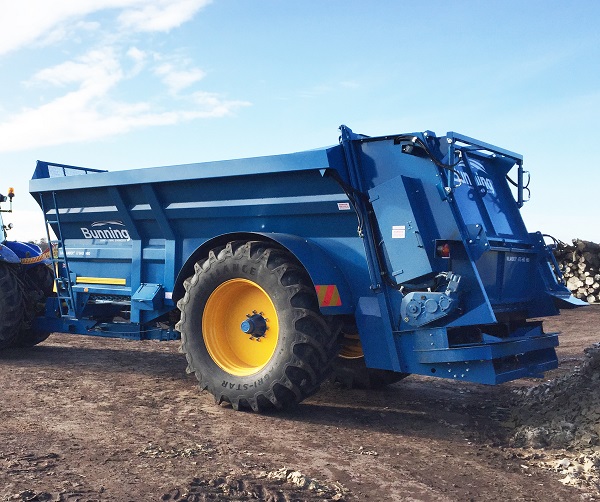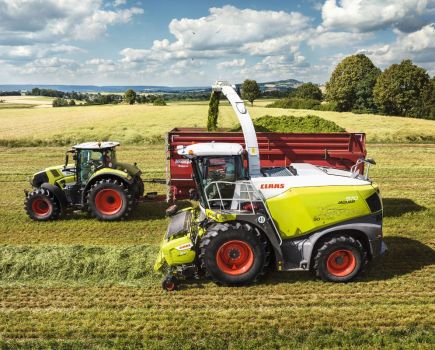Weigh cells and an electronic monitoring and control system equip a novel manure spreader for precision application and data recording. CPM reports on a host of new product and update introductions.
Weigh cells enable the ISOBUS-compliant control terminal to regulate conveyor speed relative to ground speed.
By Peter Hill
Manure spreaders are no longer lumbering, inaccurate machines distributing unknown quantities in large lumps around your fields. They’ve seen improvements to shredding and spreading mechanisms for even distribution. What’s more, there’s increased availability of on-board weighing and application rate control systems.
Shredding effect
The Xcel spreader built in Ireland by HiSpec Engineering uses a rear-mounted chain flail spreading mechanism that emulates the shredding effect of ‘sideflinger’ spreaders.
But this layout provides much greater load capacity – up to 12t – with materials such as yard manure, sludge cake, muck lime, wood mulch and chicken litter discharged typically in 3-5 mins.
A single slat conveyor using two marine-grade chains with variable-speed hydraulic drive feeds the shredding mechanism, which comprises 22 heavy duty chains, each carrying a 22mm Hardox steel flail head.

Maximum capacity on a single axle is the main characteristic of the Lowlander 175 Heavy Duty manure spreader from G T Bunning.
These are enclosed by a hood, made from 4mm wear-resistant Hardox steel, for maximum shredding and an adjustable plate fine-tunes the flow of shredded material on to the two spinners that distribute across widths up to 24m.
This makes the machine suitable for use in controlled traffic systems with permanent tramlines at that spacing, says HiSpec Engineering.
Weigh cells fitted to the chassis when the optional precision spreading option is added enable the ISOBUS-compliant RDS iSOCAN Apollo control terminal to regulate conveyor speed relative to ground speed to maintain a consistent application rate.
And since the colour touch-screen terminal is compatible with third party precision farming products with GPS, the spreader can work to variable application maps and automatic headland on/off control.
Alternatively, the simpler Digi-Star GT400 weighing system can be installed for operators who simply want to record the amount of product applied.
Spreading versatility
A new rear shroud option for Pichon rear-discharge manure spreaders is designed to increase the machine’s spreading versatility for handling materials from light chicken muck to dense yard manure..
The doors open and close hydraulically using a spool valve on the tractor so they can remain in place regardless of whether compost, digestate cake, lime or gypsum is being spread in swaths up to 20m wide.
Pichon claims its beaters are the largest available at 1035mm diameter; they are fed by 70mm removable slats on 16mm bed chains.
The French manufacturer’s range extends from 8-24m3 capacity using heavy duty construction and a fully galvanised finish to ward off corrosion.
The spreaders run on a single 10-stud axle with hydraulic brakes.
Variable application
Two new control systems available on two new spreaders from Samson Agri automatically regulate the required application rate and can incorporate a weighing facility for added functionality.
The SpreadMaster 6500 unit regulates the bed conveyor speed in proportion to the spreader’s ground speed, which may vary when travelling up or down-hill, to provide more precise dosage of the material being applied.
It can count spreading time, theoretical weight and the number of ha, and can be upgraded to perform volumetric dosing.
The more sophisticated SpreadMaster 8500 system can perform all types of dosing control approaches by using a built-in weighing system.
It can also dose according to application maps and create an as-applied map with accurate dosage data.
The new control and weighing options are available on the 20m3 Samson Flex II 20E, which is a new variant in the Flex range, comprising four base models with capacities from 16-23m3.
All can be had with a twin vertical beater spreading mechanism working to 12m swath widths or a twin horizontal beater set-up feeding large discs behind a side-hinged shroud that can send material across 24m.
Options include a galvanised steel slurry gate, hydraulic floor chain tensioning and a hydraulic cylinder on the drawbar to transfer greater weight to the tractor’s front wheels for improved traction.
The Flex 16 and 19 run on a single axle, while the Flex 20 and 23 have Samson’s novel ‘bogie wheel’ installation that pairs a 600/65 R34 main tyre with a 600/65 R22.5 on either side.
However, the 20E version introduces a large diameter single wheel option.
The Samson US is a new line of universal spreaders with horizontal beaters and a newly-developed disc spreading table.
A relatively low loading height is claimed for the spreaders, which take the Danish manufacturer into the so-called ‘wide box’ segment with four sizes starting at 28m3 and topping out with the 40m3 capacity triple-axle US 340 model.
New body design
A second model has been added to the Maelstrom vertical beater manure spreader range from Harry West (Prees), which introduced a new body design and other upgrades when the 10m3 model replaced the company’s previous design last year.
The Maelstrom 8 has a level-fill capacity of 5.6m3 – around 8m3 heaped – within a 1.5m wide body and uses a pair of 14mm bed chains with pad-less connectors on every bar and 24mm adjusters to take up any slack.
The bed conveyor shifts the load to twin upright beaters that spin at 400rpm from a 1000rpm pto input to achieve up to 12m wide coverage, depending upon the material being spread.
Running gear comprises a single rigid axle on 18.4/34 tyres, which can be substituted for alternative sizes.
Harry West’s larger Maelstrom 14 moved the original design from straight sides to include a flared upper section that increases capacity for the same footprint.
In this case, capacity is just over 10m3 filled level or 14m3 with a more typical heaped load, which is moved to the beaters by slats on 18mm marine-grade chains.
The machine weighs a little more than 6t and measures 8m from tip to toe and comes with a leaf spring suspension drawbar as standard.
Both spreaders have new LED lights and are available with a guillotine slurry door, electric operation of the hydraulic functions, GPS satellite location and a weighing system.
These options add accurate application recording and variable rate control capability, respectively.
High throughput
Maximum capacity on a single axle is the main characteristic of the Lowlander 175 Heavy Duty manure spreader from G T Bunning.
Aimed at contractors and larger farms, the machine runs on a 150mm square solid axle rated at 30t, with 420mm x 200mm drum brakes and 710/70R42 heavy load rating tyres.
There’s also a heavy duty sprung drawbar to help control ride characteristics of the spreader and tractor along field access tracks and back roads.
Floor chains rated at 50t convey a 25m3 heaped load in the low-profile body, which has flared upper sections similar to those of the Bunning Widebody spreaders made famous on the BBC Top Gear programme for shredding an entire Volvo saloon car – less engine and transmission – before being shipped to a customer in Australia.
Material is discharged from either twin vertical beaters or enclosed horizontal beaters and discs – a set-up that suits spreading of lighter materials such as compost and chicken manure.
Application rate control
An ISOBUS-compatible weighing and application rate control system is now available across the range of spreaders produced by K Two at its Bucks factory.
The RDS ISOBUS Apollo ECU controller becomes the standard fitment for all weigh cell and application rate control systems specified by users, and this can be supplied in three different variations.
A ‘bare’ ISOBUS Apollo option comes with an ISOBUS cable to connect to a compatible third party console for the tractor cab or it can be supplied with the RDS iSOCAN touch-screen monitor to give full application rate control and mapping capability with a GPS link.
The third option is Apollo with a Topcon X25 touch-screen console, which also provides ISOBUS and the same functionality as the iSOCAN but with the addition of automatic headland on/off control, on-screen guidance and a live coverage map that can be downloaded for farm management and assurance records.
K Two produces vertical beater spreaders in the Eco, Duo and Evo ranges with single-axle, large wheel running gear from 7.8-25.4m3 capacities and the 28.4m3 capacity Evo 1820 on tandem axles.
Sliding bulkhead
New production tools at the company’s Aberdeenshire factory have helped Marshall Trailers update its Vesuvius Vantage manure spreader with a revamped body and new holders for the spreading beaters.
The Vantage is unusual for having a sliding bulkhead to move its contents towards the two vertical beaters mounted at the rear, so there are no bed chains to maintain and adjust or to replace when they break with a load of muck in the spreader.
Marshall has patented the three-stage hydraulic cylinder mechanism that moves the bulkhead and it’s mounted at the front outside the body, so that apart from being simple with very moving parts, it’s easily accessible if a seal needs replacing.
About a tonne extra capacity results from replacing the vertical sides of the previous version with the new flared upper sections, so the three models are now rated 10t, 13t and 15t capacity or 8000, 9870 and 12,250 litres in volume terms.
A removable slurry door is standard and also at the rear are new beaters with larger reversible tips held in folded carriers that are welded to the tube.
The new carriers with folded edges protect the bolt heads from being rounded off, making it easier to remove them in order to reverse or replace the tips.




